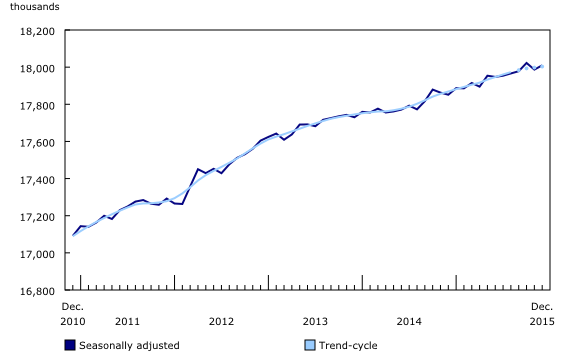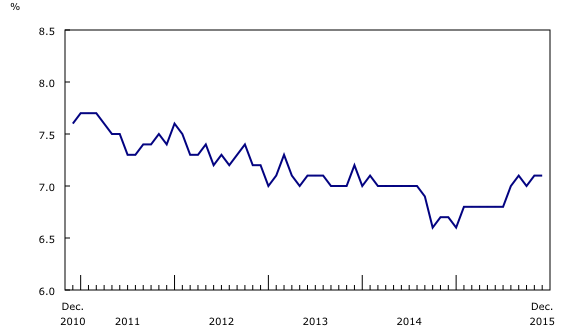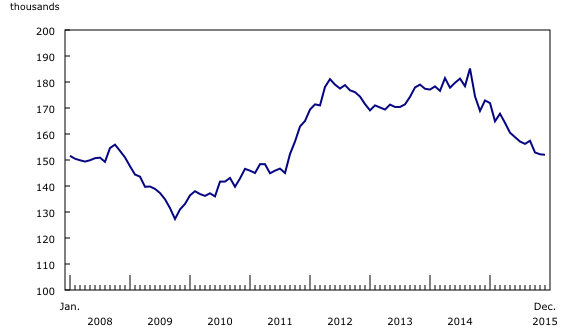Labour Force Survey, December 2015
Archived Content
Information identified as archived is provided for reference, research or recordkeeping purposes. It is not subject to the Government of Canada Web Standards and has not been altered or updated since it was archived. Please "contact us" to request a format other than those available.
Released: 2016-01-08
Employment edged up 23,000 (+0.1%) in December and the unemployment rate was 7.1%, unchanged from the previous month.
Following employment growth of 0.4% in the first quarter of 2015, the pace of growth slowed to 0.2% for each of the subsequent three quarters.
In the 12 months to December, employment gains totalled 158,000 or 0.9%, slightly above the growth rate of 0.7% in both 2013 and 2014. A year-end review for 2015 is presented in a separate section below.
In December, employment increased among people aged 55 and older and was little changed for the other demographic groups.
Provincially, employment rose only in Ontario, while it declined in Saskatchewan, Nova Scotia, Newfoundland and Labrador as well as Prince Edward Island.
There were more people employed in health care and social assistance, educational services, and finance, insurance, real estate and leasing. At the same time, employment declined in accommodation and food services as well as agriculture.
The number of self-employed increased in December, while there was little change among public and private sector employees.
Employment gains continue among people aged 55 and older
In December, employment rose by 29,000 among people aged 55 and older, and their unemployment rate edged down to 5.8%.
Despite little employment change among people aged 25 to 54, their unemployment rate increased 0.2 percentage points to 6.3% as more of them searched for work.
Employment was also little changed among youths aged 15 to 24 and their unemployment rate was 13.0% in December.
Employment up in Ontario
Ontario was the lone province with employment growth in December, up 35,000. This lowered the unemployment rate in the province by 0.2 percentage points to 6.7%.
In December, employment in Saskatchewan was down 4,600 and the unemployment rate held steady at 5.5%, as fewer people participated in the labour market.
In Nova Scotia, there were 3,000 fewer people employed. However, the unemployment rate was unchanged at 8.6% as fewer Nova Scotians participated in the labour market.
Employment in Newfoundland and Labrador declined by 2,700. The unemployment rate increased 1.4 percentage points to 14.4%, the highest rate in the province since December 2010.
In Quebec, employment was little changed for the fifth consecutive month in December. However, the unemployment rate was up 0.3 percentage points to 7.8% as more people searched for work.
Industry perspective
In December, employment increased by 17,000 in health care and social assistance, 15,000 in educational services and 10,000 in finance, insurance, real estate and leasing.
Conversely, employment declined by 14,000 in accommodation and food services and 7,900 in agriculture.
In December, the number of self-employed increased by 40,000, while the number of private and public sector employees was little changed.
Quarterly update for the territories
The Labour Force Survey also collects labour market information about the territories. This information is produced monthly in the form of three-month moving averages.
Employment was little changed in Yukon, the Northwest Territories and Nunavut between the third and the fourth quarter of 2015.
Over this period, the unemployment rate was unchanged for both Yukon (5.3%) and Nunavut (17.2%). In the Northwest Territories, the unemployment rate increased by 1.1 percentage points to 9.9% in the fourth quarter as more people searched for work.
Year-end review, 2015
The following analysis focuses on changes from December 2014 to December 2015.
Employment gains totalled 158,000 or 0.9% in 2015, slightly above the growth rate of 0.7% over the same period in 2013 and 2014.
Full-time employment rose by 151,000 or 1.0% in 2015, while part-time work was little changed. During the same period, the number of hours worked increased by 1.0%.
In the 12 months to December, the unemployment rate increased 0.4 percentage points to 7.1%. This increase was attributable to more people searching for work (+110,000). Over the same period, the participation rate increased 0.2 percentage points to 65.9%, while the employment rate was little changed at 61.2%.
Fastest employment growth in British Columbia in 2015
Provincially, the fastest employment growth in 2015 was in British Columbia, up 2.3% (+52,000). Employment in the province has been on an upward trend since April. Despite this increase, the unemployment rate rose 1.2 percentage points to 6.7% as more people searched for work.
In Ontario, employment increased 1.2% (+81,000) in 2015, as gains in full-time work (+143,000) were partly offset by losses in part time. The unemployment rate was little changed at 6.7% as more people participated in the labour market.
Employment in Quebec also increased 1.2% (+48,000), all in full-time work and driven by gains in the first four months of the year. The unemployment rate was little changed at 7.8%, the result of more people looking for work.
In Alberta, overall employment was little changed as declines in full-time employment were offset by gains in part-time work. The number of hours worked fell by 4.3% in 2015 compared with 2014. Over the same period, the unemployment rate rose from 4.7% to 7.0%, as more people were searching for work (+58,000). The last time the unemployment rate in Alberta was above 7.0% was in April 2010.
Newfoundland and Labrador was the lone province with a decline in employment in 2015, down 1.8% (-4,300), as losses in full-time work were only partly offset by gains in part time. The unemployment rate increased 2.6 percentage points to 14.4%.
Service sector leads employment growth
In 2015, employment in professional, scientific and technical services grew by 5.2%, following little change in 2014.
There were also more people employed in health care and social assistance (+3.8%) in 2015, continuing a long-term upward trend. The bulk of the employment increase in 2015 was in hospitals.
Employment in manufacturing rose by 2.1% in 2015, the first increase since 2012. The employment gains in 2015 were spread across several manufacturing industries, and mostly in British Columbia.
Employment in natural resources fell 6.8%. Most of this decline was in Alberta. However, there were also smaller declines in Saskatchewan, Newfoundland and Labrador as well as Nova Scotia. At the national level, the largest declines were in the support activities for mining and oil and gas extraction.
In accommodation and food services, employment declined by 2.3%, mostly in Alberta and British Columbia.
In 2015, self-employment rose by 92,000 (+3.4%), with increases across a number of industries in the service sector. The number of public sector employees increased by 41,000 (+1.1%), driven by gains in health care and social assistance and, to a lesser extent, in public administration. At the same time, the number of private sector employees was little changed.
Demographic highlights
Among the major demographic groups, only men and women aged 55 and older recorded employment growth in 2015, up 6.3% (+220,000). Over the same period, their population rose by 310,000. The participation rate for this group increased 1.2 percentage points to 37.8%, as growth in labour market participation outpaced population growth over the period. The unemployment rate for this group was little changed at 5.8%.
In the 12 months to December, employment was little changed among people aged 25 to 54, as was their population. However, their unemployment rate increased 0.8 percentage points to 6.3% as more of them searched for work.
Employment among youths aged 15 to 24 fell 1.9% (-48,000), while their population declined by 43,000. Despite the decline in employment, their unemployment rate was little changed at 13.0%, as fewer youths participated in the labour market.
Upcoming revisions
A standard revision to the Labour Force Survey (LFS) data will be released on January 26 and 27.
Occupation data estimates will be reclassified to the 2011 National Occupational Classification from the 2006 National Occupational Classification for Statistics.
New CANSIM tables will be created for all occupation-related series and will be available from the start of each respective series. A list of the occupation tables is now available.
At the same time, the North American Industry Classification System (NAICS) 2012 will replace the NAICS 2007. This change will not affect the CANSIM tables for the LFS as there were only minor changes at the four-digit level.
In addition to updating the classification systems, the LFS seasonally adjusted estimates will be revised back to January 2013 using the latest seasonal factors. The revised estimates will be available in CANSIM on January 26.
Note to readers
The LFS estimates for December are for the week of December 6 to 12.
The LFS estimates are based on a sample and are therefore subject to sampling variability. As a result, monthly estimates will show more variability than trends observed over longer time periods. For more information, see the article "Interpreting Monthly Changes in Employment from the Labour Force Survey." Estimates for smaller geographic areas or industries also have more variability. For an explanation of sampling variability of estimates and how to use standard errors to assess this variability, consult the "Data quality" section of the publication Labour Force Information (71-001-X).
This analysis focuses on differences between estimates that are statistically significant at the 68% confidence level.
The employment rate is the number of employed persons as a percentage of the population 15 years of age and over. The rate for a particular group (for example, youths aged 15 to 24) is the number employed in that group as a percentage of the population for that group.
The unemployment rate is the number of unemployed as a percentage of the labour force (employed and unemployed).
The participation rate is the number of employed and unemployed as a percentage of the population.
For more detailed information, see the Guide to the Labour Force Survey (71-543-G).
Seasonal adjustment
Unless otherwise stated, this release presents seasonally adjusted estimates, which facilitates comparisons by removing the effects of seasonal variations. For more information on seasonal adjustment, see Seasonally adjusted data – Frequently asked questions.
Chart 1 shows trend-cycle data on employment. These data represent a smoothed version of the seasonally adjusted time series, which provides information on longer-term movements, including changes in direction underlying the series. These data are available in CANSIM table 282-0087 for the Canada-level employment series. For more information, see the StatCan Blog and Trend-cycle estimates – Frequently asked questions.
Next release
The next release of the LFS will be on February 5.
Products
A more detailed summary, Labour Force Information (71-001-X), is now available for the week ending December 12. From the Browse by key resource module of our website under Publications, choose All subjects then Labour.
Summary tables are now available online. From the Browse by subject module of our website, choose Labour.
Contact information
For more information, contact us (toll-free 1-800-263-1136; 514-283-8300; STATCAN.infostats-infostats.STATCAN@canada.ca).
To enquire about the concepts, methods or data quality of this release, contact Vincent Ferrao (613-951-4750; vincent.ferrao@canada.ca) or Lahouaria Yssaad (613-951-0627; lahouaria.yssaad@canada.ca), Labour Statistics Division.
- Date modified:





